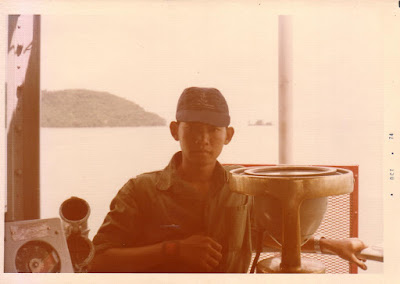Lesson Plan
The purpose of this training was to expose us to maritime operations. It allowed us to put into practice all that we had studied in classroom during the last 6 months. This was especially so for seamanship and navigation. The sea training was also to give us greater appreciation and awareness of the duties of the sailors.
The purpose of this training was to expose us to maritime operations. It allowed us to put into practice all that we had studied in classroom during the last 6 months. This was especially so for seamanship and navigation. The sea training was also to give us greater appreciation and awareness of the duties of the sailors.

We had to spend time in the engine room, operate electronic and communications equipment as well as the ship radar system. One of the most tiring jobs was ship maintenance. This included chipping away the rust, paint with red oxide followed by another layer of paint. Painting shipside requires the use of hanging (Boson) ladder. We were taught on handling the ropes and fenders when the ships enter or leave the harbour.
People skill
The ship environment is very different from that of the army. Here everyone is sort of a specialist and almost indispensible. Interpersonal and communication skill are very vital to get the ship's crew to accomplish a mission. The leadership skill of the naval officer is very different from that of an army officer. We were taught to be humble and learn as much as possible from the experience sailors. Not only did we learned a lot, but also earned their respect. Ironically, someday we became their boss.
Weather and the Environment
We had been baptised by the storm at the Bay of Bengal and successfully 'commissioned' our sea legs. This part of the training can never be simulated in the classroom. We had learned to appreciate the wind, rain and thunderstorm in the ocean, the darkness in the empty ocean at night. The high wave and the monster swell were a lesson of humility and opened our eyes to the power of nature. We learned to be safe and make the necessary adjustment and adapt according to the changing environment. One of the biggest lessons I learned was to be ‘ship shape’. It simply means to be prepared and ready for any impending adverse weather or any unforseen situation. This applies to our daily life.
Understudy the ship’s officer
Watch keeping was another part of the job training. Here we learned from the experience officer the essential of keeping the ship safe and avoiding collision. Rules of the Sea must be observed. Some of the seasoned officers were really tough and asked a lot of questions. But we learned despite being humiliated at times.

Each watch was 4 hours. The most tiring watch was the from midnight to 4 in the morning. The 'OOW' or officer of the watch has 2 lookouts and l radar operator. Captain of the ship never kept watch; he is only on the bridge when the ship leaves and enters harbour or in emergency. Up on the bridge can be very boring but can also be a serence and peaceful place for time to reflect, especially during dark night filled with stars while the ship sailed through the calm sea.
Communication
The ship was equipped with all kind of communication equipment from VHF to HF. Besides using electronic, the navy ship also communicates using light and flags when in close range to prevent enemy interception. We learned to send and receive messages through flashing lights. The use of Morse-code on the radio set was beyond us. But we need to memorise all the flags that represent each alphabets and numerals. These were normally used to identify or represent the ship’s status when operating in a fleet.
Celestial Navigation
The major exercise was celestial navigation. It was a bread and butter subject for naval officer whether in the military or merchant navy. 3 times a day, dawn, noon and dusk, we had to use the marine sextants to ‘shoot’ the stars, moon and sun to obtain their inclinations from the horizon. Then we went through a set of calculation to determine the ship’s position. More details on my next blog.
------------------------------------
Communication
The ship was equipped with all kind of communication equipment from VHF to HF. Besides using electronic, the navy ship also communicates using light and flags when in close range to prevent enemy interception. We learned to send and receive messages through flashing lights. The use of Morse-code on the radio set was beyond us. But we need to memorise all the flags that represent each alphabets and numerals. These were normally used to identify or represent the ship’s status when operating in a fleet.
Celestial Navigation
The major exercise was celestial navigation. It was a bread and butter subject for naval officer whether in the military or merchant navy. 3 times a day, dawn, noon and dusk, we had to use the marine sextants to ‘shoot’ the stars, moon and sun to obtain their inclinations from the horizon. Then we went through a set of calculation to determine the ship’s position. More details on my next blog.
------------------------------------
No comments:
Post a Comment